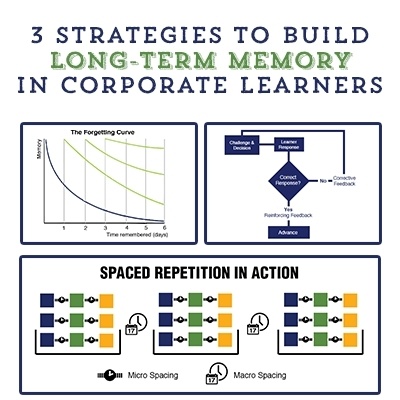What eLearning Professionals Should Know About Long-Term Memory
The long-term memory of your learners is your final destination when you are designing and developing an eLearning experience. As its name suggests, long-term memory, unlike short-term memory, stores information for a long time; it is debatable whether “long time” means a lifetime, but undoubtedly the relatively permanent memory storage of your audience is where you want your eLearning course to find its place. The long-term memory, in particular, allows your audience to retain and recall the concepts and ideas that they need outside the virtual learning environment. To create an effective, unforgettable eLearning course, it is essential to have an in depth understanding of how the information will be remembered. In this article, I'll delve into the topic of long-term memory and I'll share some useful strategies to help you make sure that your learners retain your eLearning content.
The Long-Term Memory Types
Many cognitive psychologists believe that the long-term memory is divided into two distinct types: explicit memory and implicit memory.
- Explicit or Declarative Memory.
Explicit memory, also known as declarative memory, is made up of memories that we are conscious of remembering and capable of describing in words. Explicit memory can be subdivided into semantic memory, which refers to our memories that are drawn from common knowledge, such as facts and general knowledge about the world, for example the names of colors, and episodic memory, which refers to memories that are drawn from our personal experiences. - Implicit or Non-Declarative Memory.
Implicit memory, also known as non-declarative memory, consists of subconscious memories, like knowledge that allows us to carry out basic tasks without even realizing we are recalling the information. For example, when you type on a keyboard you are not conscious of the long-term memories that are allowing you to perform the function. Information that is encoded in implicit memory, such as knowledge concerning our body movements, can be recalled automatically, without us needing to make a conscious effort. Because it flows effortlessly in our actions, it is often difficult to be verbalized, that's why it's also known as “non-declarative”. Implicit memory can also be subdivided in two types: procedural, which refers to recalling how to do things that require action, such as walking or playing the piano, and priming memory, referring to the automatic activation of certain associations of new with previous knowledge. A popular example that describes how priming memory works is that when one reads the word “yellow”, they will recognize the word “banana” slightly faster than the word “sea”.
Cognitive Processes Involved In The Long-Term Memory
Long-term memory is not just a permanent storage that archives information. It also involves other cognitive mechanism such as providing the working memory with relevant background information in order for the latter to acquire meaning. The long-term memory, therefore, performs three basic operations: encoding, storage, and retrieval.
- Encoding.
Encoding is the ability to convert data we collect into a knowledge-based structures known as schemata. New information is either just added to existing schemata enriching them, or contradicts with them and finally manages to alter them. The first process is known as assimilation, though the second as accommodation. - Storage.
Simply put, storage is the ability of long-term memory to store information in different brain areas. For example, semantic memories, such as facts are stored in different brain areas than automating procedural memories, such as how to ride a bike. We cannot be sure, neither for how long, nor for how much information can be stored in the long-term memory. Theoretically speaking, the long-term memory has unlimited capacity and information there can be stored for the rest of lives. It is also still debatable whether information stored in long-term memory can be permanently deleted, as "deletion” may involve just inability to locate or retrieve information, rather than permanent loss. It has been found that forgetting is basically the result of either poor initial encoding of information or poor retrieval methods. - Retrieval.
Retrieval, or else, remembering. Retrieval of information is the process of not only activating, but also using information that is stored in long-term memory. There are two distinct forms of retrieval: recall, which refers to generating or reproducing stored information we've already acquired, and recognition, which refers to identifying stored information that is familiar. Needless to say, recognition is much more effective than recall, as meaningful associations don’t require as much depth of processing or cognitive effort.
Enhancing Long-Term Memory: 7 Strategies for eLearning Professionals
Indeed, it is quite challenging to find how to process information in ways that will keep it fresh and accessible. This is where your eLearning skills come in. In order to help your learners retain your eLearning content, consider using the following memorization strategies:
- Repeat, repeat, repeat.
Fascinating brain fact: We have 100.000.000.000 (one hundred billion!) neurons in our brain and each of them is connected to 1000 others. Neurons’ main role is to transfer information by “firing” impulse signals to their neighbors, who transfer the same signals to other "neighbors" of theirs, and so on. It's exactly like a domino effect. The connection between two neurons is called “synapse” and it increasingly gets stronger, the more frequent the signals between two neurons become. Because memories, just like thoughts, are represented by the resulting patterns of neuron firing, the stronger the synapse between two neurons, the more reinforced a trace of memory becomes and the higher the likelihood to be retrieved. This is where you come in; as an eLearning professional, wanting to offer your learners a memorable eLearning course, you need to find a way to strengthen the neural networks in their brains. You don’t need to have a neuroscience degree to do this: Just repeat the information you offer them over and over again. For example, repeat your eLearning objectives and goals throughout the eLearning course, use keywords as often as possible and don’t forget to summarize each section or topic after completion. This way, it will be more likely for the information to end up in the long-term memory of your learners, and they will be able to remember it with greater ease and accuracy later. - Use multiple ways to present the information.
Repetition allows your learners to soak up the information more rapidly and for longer spans of time, even concepts that may be more difficult to understand. However, it’s important to switch up the formats in which the information is delivered. If you give them the information via a scenario in one lesson, provide it in multimedia format or as a story in the next. Not only will this raise your learners’ interest in the eLearning content, but it will also improve retention. For example, creating an audio narrative of the information followed by a video presentation that emphasizes similar key points will appeal to auditory learners as well as visual learners. - Think of REM (Relevance, Emotion, Meaning).
REM initials here neither stand for Rapid Eye Movement sleep nor the famous rock band; instead, they refer to 3 essential eLearning course qualities: Relevance, Emotion, Meaning. I'm sure you will definitely remember this tip. Why? Because I've just followed a great memory strategy; I related a new piece of information to an already existing, familiar one. Information can be tranferred from short-term to long-term memory only when it's meaningful. To facilitate information transfer to the long-term memory, create meaningful eLearning courses. - Integrate stories that trigger an emotional connection.
Follow an emotional approach that will engage your audience, and provide your learners with eLearning content that they feel they can relate to. Learners are more likely to remember information when it’s tied to a personal experience or an emotion. For example, if you include stories in your eLearning course that are relatable for your audience, they will automatically pair the semantic memories (facts) with their episodic memories (personal experiences). This enables them to create an emotional connection with the subject matter and store it away in their long-term memory. Make sure that your stories are actually linked to the learning goals and objectives, or else they simply won’t provide your learners with any real value. - Use scenarios and simulations to access previously learned subject matter.
Scenarios and simulations take active retrieval a step further by immersing your learners in the subject matter. They are then able to make meaningful connections between what they stored in their long-term memory and real world applications of that information. It’s also important to create exercises that mimic real world challenges or fit into the context of how they will be applying the knowledge outside the virtual classroom. For example, if they must learn how to perform a basic customer service task, develop a scenario that tests the skills and steps that are involved in the activity. This will encourage their brains to link the knowledge to that particular process, which will make it easier for them to recall it in the future.Design the Best Learning Experience for your Adult Learners with the Most Engaging Branching Scenarios!Discover, choose and compare the top eLearning Authoring Tools with Branching Scenarios Functionality! - Use chunking. Break the eLearning course into bite-sized lessons.
Distributed practice is the key to knowledge retention. Break your eLearning course into smaller lessons that are easier for your learners to digest, rather than overwhelming them with too much information at once. This gives them the ability to gradually absorb the information and assimilate it into their long-term memory, rather than forgetting key concepts just seconds after they’ve learned them. The chunking method was first introduced by a pioneer in the field of cognitive psychology, George A. Miller, and it refers to taking individual units of information and grouping them together, so that it is easier to store large amounts of data in the short-term memory. Chunking can be particularly helpful to eLearning professionals, as it enables you not only to get rid of useless information, but also to effectively organize and structure your eLearning course. Prioritize your material by choosing primary and secondary points, and divide your eLearning content into sections. Use different screens for each topic and highlight key ideas by using bullets and numbered lists and colors or bolded fonts in order to make them stand out in the minds of your learners. Finally, if you are integrating images and multimedia into your chunking method, keep in mind that they need to be relevant to your audience. This way, they will be provided with a clearly structured, meaningful and memorable eLearning experience. - Prompt your learners for “active retrieval” of previous knowledge.
When you encourage your learners to retrieve memories from the long-term memory banks, you are tapping into the power of “active retrieval”, which helps to improve knowledge retention and reduces the risk of memory decay, by actively involving your audience in the eLearning activities you provide. It’s a good practice, these eLearning activities and assessments to prompt your learners to make use of previously acquired knowledge in order to be able to answer correctly. Rather than simply reading a summary of what they have learned so far, it is believed that recalling and utilizing information is much more effective than simply reviewing it.
The ultimate goal of any online learning experience is to provide the long-term memory with usable material for the future. It is to stick in the minds of its learners, so that they are able to delve into the depths of their memory to apply what they have learned in the real world.
Now that you know how long-term memory works and how to use the facts for the benefit of your eLearning course, you may be interested in busting some memory myths. Read the article Memory: Types, Facts, and Myths and find the truth behind the 7 most common memory misconceptions.
Also, there are many more ways to keep learners interested and refresh their memory. In our ultimate guide, Plan Augmented Reality Training On Budget: The Ultimate Guide For L&D Professionals, you’ll find out how AR can help the information stick and fully engage your learners. Read about the most common mistakes, so you’ll know what to avoid, as well as some of the most popular myths around the topic. Discover useful tips on how to develop AR training strategies from scratch and how to find the perfect partner to help you with the process. Download your copy today to launch a successful AR training program.








